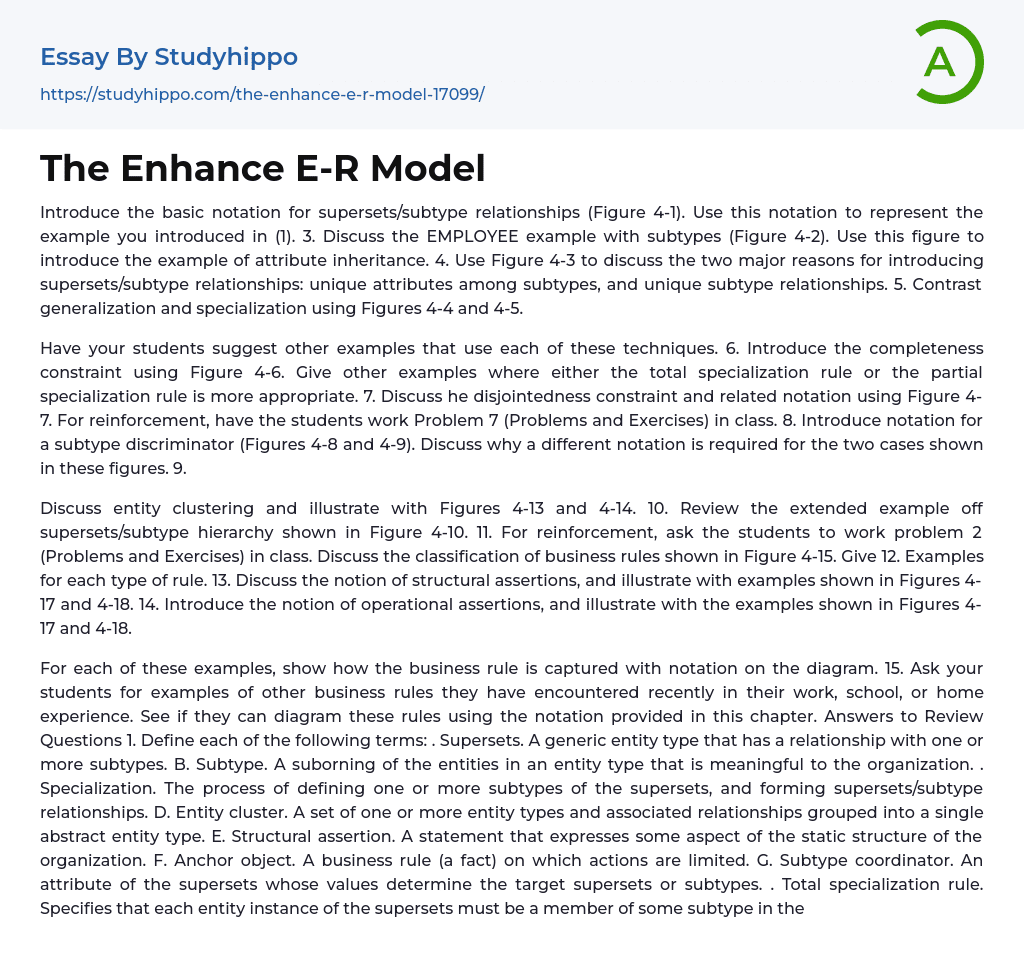Introduce the basic notation for supersets/subtype relationships (Figure 4-1). Use this notation to represent the example you introduced in (1).
- Discuss the EMPLOYEE example with subtypes (Figure 4-2). Use this figure to introduce the example of attribute inheritance.
- Use Figure 4-3 to discuss the two major reasons for introducing supersets/subtype relationships: unique attributes among subtypes, and unique subtype relationships.
- Contrast generalization and specialization using Figures 4-4 and 4-5. Have your students suggest other examples that use each of these techniques.
- Introduce the completeness constraint using Figure 4-6. Give other examples where either the total specialization rule or the partial specialization rule is more appropriate.
- Discuss he disjointedness constraint and related notation using Figure 4-7. For reinforcement, have the students work Problem 7 (Problems and Exercises) in class.
- Introduce
...notation for a subtype discriminator (Figures 4-8 and 4-9). Discuss why a different notation is required for the two cases shown in these figures.
- Discuss entity clustering and illustrate with Figures 4-13 and 4-14.
- Review the extended example off supersets/subtype hierarchy shown in Figure 4-10.
- For reinforcement, ask the students to work problem 2 (Problems and Exercises) in class. Discuss the classification of business rules shown in Figure 4-15. Give
- Examples for each type of rule.
- Discuss the notion of structural assertions, and illustrate with examples shown in Figures 4-17 and 4-18.
- Introduce the notion of operational assertions, and illustrate with the examples shown in Figures 4-17 and 4-
- For each of these examples, show how the business rule is captured with notation on the diagram.
- Ask your students for examples of other business rules they have encountered recently in their work, school, or home experience
View entire sampleJoin StudyHippo to see entire essay
See if they can diagram these rules using the notation provided in this chapter. Answers to Review Questions
Define each of the following terms: . Supersets.
- generic entity type that has a relationship with one or more subtypes.
- Subtype. A suborning of the entities in an entity type that is meaningful to the organization.
- Specialization. The process of defining one or more subtypes of the supersets, and forming supersets/subtype relationships.
- Entity cluster. A set of one or more entity types and associated relationships grouped into a single abstract entity type.
- Structural assertion. A statement that expresses some aspect of the static structure of the organization.
- Anchor object. A business rule (a fact) on which actions are limited.
- Subtype coordinator. An attribute of the supersets whose values determine the target supersets or subtypes. . Total specialization rule. Specifies that each entity instance of the supersets must be a member of some subtype in the relationship.
- Generalization. The process of defining a generalized entity type from a set of more specialized entity types
- Disjoint rule. Specifies that if an entity instance (of the supersets) is a member of one subtype, it cannot simultaneously be a member of two (or more) subtypes.
- Overlap rule. Specifies that an entity instance can simultaneously be a member of two (or more) subtypes. . Action assertion.
A statement of a constraint or control on the actions of the organization.
Match the following terms and definitions:
supersets k entity cluster structural assertion subtype a specialization d anchor object action subtype discriminator attribute inheritance b overlap rule corresponding object e g derived fact
Contrast the following terms:
- Supersets; subtype. A supersets is a generalized entity type that has
one or more subtypes, while a subtype is a suborning of the entities in a supersets.
With the overlap rule an instance of a supersets may simultaneously be a member of two or more subtypes.
- Structural assertion; action assertion. A structural assertion express the static structure of an organization whereas an action assertion is a statement of control on the actions of an organization.
- Total specialization rule; partial specialization rule. With the total specialization rule, each With the partial specialization rule, an instance of the supersets is allowed not to belong to any subtype.
Two conditions that indicate a designer should consider using supersets/subtype relationships:
- There are attributes that apply to some (but not all) of the instances of an entity type.
- The instances off subtype participate in the relationship unique to that subtype.
The reasons for entity clustering are:
- Complex enterprise-wide E-R diagram.
- Ability to have a hierarchical decomposition of data model.
- Desire to focus part of the model on an area of interest to some community of users.
- Ability to create several different entity clusters each with a different focus.
An example of a supersets/subtype
relationship: The supersets PERSON has many possible subtypes
- Programming Languages essays
- Object-Oriented Programming essays
- Java essays
- Android essays
- Application Software essays
- Benchmark essays
- Computer Network essays
- Computer Programming essays
- Computer Security essays
- Computer Software essays
- Cryptography essays
- Data collection essays
- Data Mining essays
- Graphic Design essays
- Information Systems essays
- Internet essays
- Network Security essays
- Website essays
- World Wide Web essays
- Administration essays
- Architect essays
- Discipline essays
- Doctor essays
- Engineer essays
- Farmer essays
- Hunter essays
- Labor essays
- Model essays
- Nurse essays
- Pilot essays
- Police Officer essays
- Professionalism essays
- Social Work essays
- Stakeholders essays
- Teamwork essays
- Automobile essays
- Bus essays
- Civil engineering essays
- Cycling essays
- Electric Car essays
- Genetic Engineering essays
- Hybrid essays
- Innovation essays
- Internal Combustion Engine essays
- Invention essays
- Mechanical Engineering essays
- Mechanics essays
- Software Engineering essays
- Telephone essays




